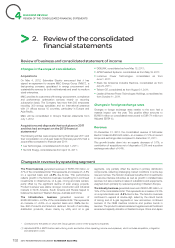APC 2012 Annual Report Download - page 145
Download and view the complete annual report
Please find page 145 of the 2012 APC annual report below. You can navigate through the pages in the report by either clicking on the pages listed below, or by using the keyword search tool below to find specific information within the annual report.
2012 REGISTRATION DOCUMENT SCHNEIDER ELECTRIC 143
CORPORATE GOVERNANCE
3
INTERNAL CONTROL AND RISK MANAGEMENT
Commitment limits and authorizations
Current management practice applies the principle of subsidiarity,
and commitment limits have been set for executives from Group
level down to the individual units.
Thus, product or service purchase and sale contracts may only be
signed by, or with the authorization of, operations correspondents
who benefi t from ad hoc authorizations which, in turn, are granted
by their managers. Within this organizational framework, Business
executives have the power to authorize the signature of product or
service, purchase or sale contracts covering up to EUR10million.
Moreover, they enable their collaborators to authorize smaller
amounts who they consider appropriate for the signature of such
contracts.
Moreover, all transactions that may affect the Group’s fundamental
interests, due to their size or nature, must be authorized in advance
by the Management Board or, in some cases, by the Supervisory
Board. This rule applies in particular to all transactions affecting the
scope of consolidation, purchases and sales of strategic assets,
trademarks and patents, and off-balance sheet commitments.
Statutory and management reporting
principles
An integrated reporting and consolidation system applicable to all
Group companies and their management units has been in place
since January 1, 2006. Statutory and management reporting
principles and support tools are available on the Group Intranet.
The subsidiaries record their transactions in accordance with Group
standards. Data are then adjusted, where necessary, to produce
the local statutory and tax accounts.
The reporting system includes consistency controls, a comparison
of the opening and closing balance sheets and items required to
analyze management results.
Key Internal Controls
A list of Key Internal Controls was drawn up in2008 and is expanded
annually. Its 114 items cover:
•the control environment (Principles of Responsibility, Delegation
of Powers, Separation of Functions, Business Continuity Plans
and Retention of Records);
•operating processes (purchases, revenues, inventories, etc.);
•accounting and fi nancial cycles;
•Human Resources, IT, Legal and Tax cycles.
The Key Internal Controls are available to all units on the Group
Intranet, along with appendices with more detailed information,
links to full policy descriptions on the Functions’ Intranets, an
explanation of the risks covered by each Key Internal Control and a
self-assessment guide.
For each cycle, the Key Internal Controls cover compliance, reliability,
risk prevention and management and process performance. The
operating units fi ll out self-assessment questionnaires concerning
the Key Internal Controls.
10.4 Risk identification and management
General risks at the Group level
The Internal Audit Department uses interviews to update the list
of general risks at the Group level each year. In 2012, 67 of the
Group’s top managers were interviewed.
The risks identifi ed through these interviews are ranked by impact
and probability of occurrence. The threat/opportunity aspect of
each risk is also taken into account.
Risk factors related to the Company’s business, as well as
procedures for managing and reducing those risks, are described in
“Risk Factors.” These procedures are an integral part of the internal
control system.
The risk matrix and the analysis of changes from one year to the
next contribute to the development of an internal audit plan for
the following year. The major and global risks were audited by the
Internal Audit Department over a period of three years to assess
action plans for managing and reducing these risks. In2012, a
third of the major and global risks identifi ed at the end of2011
were audited.
Global risks at the Operating Division level
Each Operating Division assesses its global risks and ranks them
by impact and probability of occurrence. It defi nes action plans for
reducing the major risks identifi ed.
The Internal Audit Department coordinates these assessments in
the framework of the list of global risks at the Group level each year.
Operating risks at the unit level
Operating risks are managed fi rst and foremost by the units in
liaison with the Operating Divisions, based on Group guidelines
(notably the Key Internal Controls). Each subsidiary is responsible
for implementing procedures providing an adequate level of
internal control.
The Operating Divisions implement cross-functional action plans for
operating risks identifi ed as being recurrent in the units or as having
a material impact at the Group level. The internal control system is
adjusted to account for these risks as needed.
The Group’s insurance programs cover the remaining portion of
transferable risks.
























